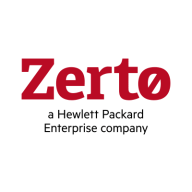


Find out what your peers are saying about Veeam Software, Zerto, VMware and others in Disaster Recovery (DR) Software.



Zerto is used for disaster recovery, business continuity, data migration, and ransomware recovery, providing continuous data protection and near real-time replication. Valued for ease of use, efficient failover processes, and versatile integration, it enhances organizational efficiency, reduces errors, and boosts productivity.
Nasuni is a file data services enterprise focused on assisting firms with their digital transformation, global expansion, and information awareness. The Nasuni File Data Platform is a suite of cloud-based services designed to enhance user productivity, ensure business continuity, provide data intelligence, offer cloud options, and simplify global infrastructure. This platform and its auxiliary services are projected to replace conventional file infrastructure such as network attached storage (NAS), backup, and Disaster Recovery (DR), with an expandable cloud-scale solution. By storing file data in scalable cloud object storage from multiple providers, Nasuni positions itself as a cloud-native alternative for traditional NAS and file server infrastructure. Based in Boston, Massachusetts, USA, Nasuni serves sectors like manufacturing, construction, technology, oil and gas, financial services, and public sector worldwide, offering its services in more than 70 countries.
James J., IT Manager at a marketing services firm, says Nasuni’s management dashboard is helpful because he's able to view all of the different filers at once rather than check each one of them individually. He values the software’s security, reliability, good performance, helpful alerting, and responsive support.
According to a Server Engineering Services Lead at a mining and metals company, Nasuni offers good OR and DR capabilities, performs well, offers data security, and continuous file versioning helps recover from hardware failures.
The Managing Director of IT at a construction company appreciates Nasuni because it eliminates a lot of work that was previously done when managing backing up and restoring data files.
Panzura CloudFS connects data across a distributed network, offering an efficient solution for file storage and management in a cloud environment.
Designed for businesses needing robust data management, Panzura CloudFS enables seamless access and high availability by providing advanced capabilities for distributed file systems. This technology ensures collaboration and data consistency across multiple locations, optimizing enterprise storage strategies and enhancing data governance and compliance. Effective in reducing latency and operational complexity, it addresses the demands of global enterprises seeking scalable and reliable cloud file services.
What are the key features of Panzura CloudFS?Panzura CloudFS finds applications in sectors such as finance, healthcare, and media, where data integrity and accessibility are critical. Financial institutions benefit from secure and synchronized data access, while healthcare providers utilize it for managing patient data across locations. The media industry leverages its capabilities for collaboration and efficient media file handling worldwide.